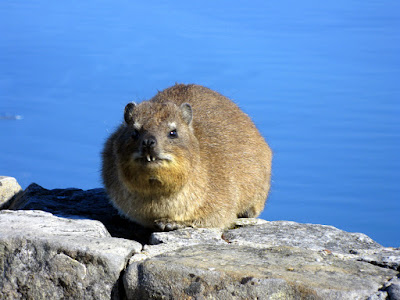Thirty-five hours of travel and we arrived in a different continent, climate and hemisphere for what certainly feels like the final stretch of our adventure - Africa!
Cape Town is our first stop in South Africa and and seemingly everyone from friends at home to fellow travelers we have met along the way, rave about Cape Town and it is easy to see why.
The "Mother City" is dramatically set against the Atlantic and framed by imposing Table Mountain, which is visible from almost anywhere in the city. We timed our visit to Cape Town to miss the World Cup (not that we don't like soccer - or as everyone outside of the states say "football" - but to hopefully avoid the expense that the World Cup brings). even though we were a week after the World Cup the city and the Country were still buzzing from it. Vendors are still out selling vuvuzelas and jerseys on every street.
 |
|
We luckily arrived to sunny weather in Cape Town and so we quickly decided to hike up Table Mountain. We have done a lot of hikes on our trip and we felt that Table Mountain was a pretty awesome day hike. The panoramic views from the top look out to lighthouses lining the cape, the city and the Atlantic. It is a gorgeous view.
Ever present at the top of Table Mountain is the Rock Dassie which is literally Dutch for Badger. These guys have become used to people on Table Mountain and they seem to ham it up for the photographers. However we are still confused by the plaque on Table Mountain which claims that the elephant's closest relative is the Dassie?
Through Cape Town's beauty there is also an infamous past. We grew up with protests against South Africa due to apartheid and it is interesting to see how South Africa is progressing. However, issues still obviously exist and the echos of South Africa's recent past still linger. Outside of Cape Town (and seemingly a lot of the cities) are townships where people live in houses made of scrap iron and other found materials. The townships were originally where the government forcibly relocated blacks further from the city center. These townships still exist post apartheid and there are movements to revitalize them and bring basic services such as water and electricity to the homes. We went to the District Six museum in Cape Town to get some small feeling of the history.
District Six was the name of an inner city area of Cape Town which was a lively community in Cape Town made up of a number of different ethnic groups.
From Wikipedia:
On 11 February 1966, the government declared District Six a whites-only area under the Group Areas Act, with removals starting in 1968. By 1982, more than 60,000 people had been relocated to the sandy, bleak Cape Flats township complex some 25 kilometers away. The old houses were bulldozed. The only buildings left standing were places of worship.
While there have been attempts at reconciliation, there have been numerous roadblocks. The museum is really interesting and has pictures and stories of the people and families who lived in District Six. It also provides a history of what happened to the area and a memorial to the destruction of the community. It is a very moving museum and very much worth spending a long time reading about the people and the history.
On our last day in Cape Town, we rented a car and headed down to Cape Point which is said to be where the Atlantic and the Indian Oceans meet. It was pretty windy but clear for some great shots of the point.
There are signs everywhere that warn that baboons are dangerous and to not have any food out or they will steal it. Well as we were walking we saw a couple sit outside right next to the signs and eat a pizza. Well, sure enough a baboon mother and baby came out and stole their pizza! No eating outside!
We headed up the eastern side of the Cape to Simon's Town where we stopped at Boulder's Beach where hundreds of Penguins crowded in the bushes to rear their young. There is a deck built along the beach that allows you to get pretty close to the penguins.
We left Cape Town to head up to the wine regions and then up the coast. Cape Town is a beautiful city and a perfect start to seeing South Africa.













No comments:
Post a Comment